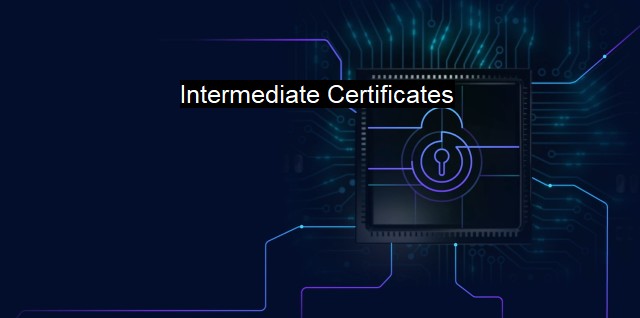What are Intermediate Certificates?
The Importance of Intermediate Certificates in Cybersecurity and Antivirus: Explained
Intermediate certificates, often known as intermediate CA certificates or just 'intermediates,' form a crucial element of trust management in encrypted communications. These intermediates bridge the gap between trusted root certificates held by a Certificate Authority (CA) and server (end-entity) certificates. This gap filling performance represents what is known as a 'Chain of Trust'.Every secure, trustworthy internet activity, such as browsing a site over HTTPS or sending an encrypted email, involves a root certificate from a Certificate Authority. These root certificates rest at the heart of the secure internet. They authenticate that the server you're speaking with is trustworthy. Each internet device, including smartphones, computers, routers, etc., possesses a 'trust store' in the firmware, containing dozens normatively up to hundreds trusted root certificates from different CAs worldwide.
a challenge resides in the fact that root certificates inevitably possess a finite lifespan. Distributing a new root certificate or revoking a compromised one calls for a fresh version of that list of trusted root certificates. Updating an inbuilt trust store is unmanageable at a significant scale. As cybersecurity gradually evolves into a persistent matter of concern, the time between required updates could prove very short and, merely patching existing vulnerabilities could just be transient relief.
This is where intermediate certificates come in. To reduce risks, Certificate Authorities seldom connect to the broader internet directly, making it incredibly challenging to distribute new root certificates. Instead, intermediates take on this workload. following the generation of root certificates, Certificate Authorities build intermediate certificates. They then hand over the intermediate certificates to servers, which maintain multiple signed intermediates.
Each intermediate certificate, ratified by its parent root, can sign further intermediates and give them rank – mimicking trust inheritance. A user, upon connecting to a server, can see its server certificate attached along with a chain of any necessary intermediates circling back to a root. Generally, your device can only glean the server certificate. By obtaining valid signed intermediates, based on a trusted root, a device bridges the 'gap of trust'. This is the core essence of the chain of trust – the transformation of a trusting bond held with a root into the server in question.
In the Leonardo da Vinci style, each link in the encrypted chain of trust represents a Mona Lisa – it's a masterpiece that cannot readily be altered. The modification path over a complete chain of trust remains one directional, cascading from root down through to server. Each intermediate holds an immutable digital signature, ensuring that alterations malicious actors could attempt would be senseless. This security establishes forward integrity and is the foundation of validation through cryptography.
Intermediate certificates rightfully deserve serious attention within the cybersecurity and antivirus ambit. Though often overlooked, intermediates nest crucial authentication controls, acting as guardians that oversee trust in billions of worldwide digital transactions daily. Without intermediates ensuring proper authentication, secure communication over the internet will be virtually impossible as they allow servers to verify a user's authenticity by assessing signed intermediates presented.
As we tread along an eon of rapidly transpiring cybersecurity developments, the role of intermediates can only be projected to surge. The digital universe leans on them to guard trust – endorsing secure communication between servers on one part of the world, smartphones on the other, and everything in-between. All factors remaining constant, the robust functionality of intermediate certificates will continually simplify more internet-connected lives while underlining secure connection and computation in the modern world.
Intermediate certificates form the bedrock of trust management in cybersecurity – certifying the authenticity of servers and effectuating global communication under encrypted coverage. They reduce risks, irrespective of how the cybersecurity landscape tends to look tomorrow, by drawing upon embedded root certificates altogether with the power of cryptography. As cybersecurity and antivirus elements stand today, securing data hinges heavily upon the application of intermediate certificates.

Intermediate Certificates FAQs
What is an intermediate certificate?
An intermediate certificate is a digital certificate that sits between the root certificate and the end-user certificate. It is used to establish a chain of trust between the root certificate and the end-user certificate, which allows the end-user to trust the authenticity of the certificate.Why are intermediate certificates important in cybersecurity?
Intermediate certificates play a crucial role in cybersecurity because they help to prevent man-in-the-middle attacks and other types of cyber threats. By establishing a chain of trust between the root certificate and the end-user certificate, intermediate certificates ensure that users can trust the authenticity of websites and other online resources.How do intermediate certificates work with antivirus software?
Antivirus software uses intermediate certificates to verify the authenticity of digital signatures and other forms of authentication. By checking the chain of trust established by the intermediate certificate, antivirus software can determine whether a file or application is trustworthy or potentially harmful.Where can I obtain an intermediate certificate?
Intermediate certificates can be obtained from certificate authorities that are trusted by web browsers and other software applications. You may need to provide some form of verification to obtain an intermediate certificate, such as proof of identity or ownership of a domain name.| | A | | | B | | | C | | | D | | | E | | | F | | | G | | | H | | | I | | | J | | | K | | | L | | | M | |
| | N | | | O | | | P | | | Q | | | R | | | S | | | T | | | U | | | V | | | W | | | X | | | Y | | | Z | |
| | 1 | | | 2 | | | 3 | | | 4 | | | 7 | | | 8 | | |||||||